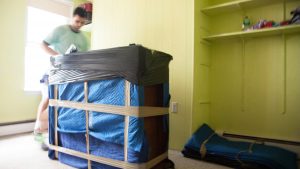Getting Friends to Help You Move Home
 If you are planning on moving home by yourself then it makes sense to get as much help from friends and family as you can, especially if you have lots to pack, or heavy furniture to be moved.
If you are planning on moving home by yourself then it makes sense to get as much help from friends and family as you can, especially if you have lots to pack, or heavy furniture to be moved.
Unfortunately moving home is no easy task and asking for help with such an arduous task is never easy. Not only is it extremely hard work but it will take up the best part of a whole day out of their busy lives.
Here are some tips to help get your friends to say yes to your request for help.
- Give your friends as much notice as possible so that they can clear their diary for you that day. The worst thing would be to ask for help at the last moment and run the risk of getting no help and having to hire some labour.
- Offer a favour in return, babysitting or helping them in some other way for example.
- Give an incentive. Moving is hard work so offer a few beers and pizza at the end of the day.
- Consider your friends’ weaknesses and strengths. If they are not so strong, don’t ask for help lifting your heavy dining table, but ask for help packing or looking after the kids on moving day.
- Make sure you have enough drinks and snacks for everyone on moving day, it will be very much appreciated.
- Plan your schedule so that you get help with the tasks before moving day, such as packing or cleaning, and on moving day itself.
- Make moving fun. Have a playlist of upbeat and happy music that will keep everyone motivated.
It is important that you are well organised if you have friends who come to help you move. Be sure that they each have a task that they are comfortable about doing and have the physical ability or skills to do.
A well-planned and organised home move will be quicker and less stressful for everyone.
You may like: How to Get Friends to Help You Move Home
How to Motivate Yourself to Pack for a Home Move
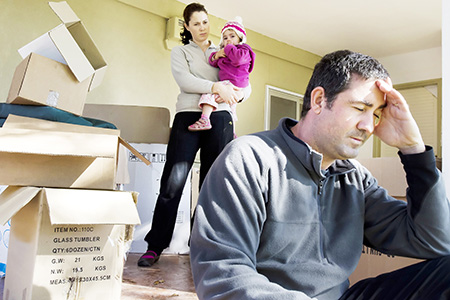 Packing for a home move is no easy task and it should not be underestimated how long and tedious a job packing is.
Packing for a home move is no easy task and it should not be underestimated how long and tedious a job packing is.
And just the sheer number of things that are in your home that need packing can seem totally overwhelming.
However, a lack of motivation to pack is usually a sign that you have no enthusiasm to move home. So you need to focus on why moving home is such a good idea and all the benefits of doing so. Once you have all those great reasons fixed in your mind you will feel the motivation flooding into you.
Often though a lack of motivation is because a partner wants or needs to move home but you don’t. This is a common problem but can often be resolved. You will find lots of useful advice on how to overcome this problem in: My Partner Wants to Move Home, I don’t. Now what?
Equally, it could be that you love your current home so much that leaving it, although for all the right reasons, is very hard to do. You will find lots of useful tips and advice in: How to Move Out of a Home you Love.
Having identified and resolved why you have a lack of motivation you can move on and start little by little, the move to your new home.
Your first task should be to reduce the number of items you need to pack and move. Once you have got rid of all those things you no longer need or love packing will not seem such a huge task.
Start by sorting through things that you have no emotional attachment to. This will make it easier to get into the mind frame of decluttering.
Sort through an easy room to start with. Go through everything and decide whether it will be thrown out, donated to charity, or sold. Once you have these three piles of things, you will be left with only the things you love and really need to be packed.
Pack those things into boxes, bag up each of the other 3 piles and that is your first room finished. Completing bite-sized chunks and seeing the results will soon motivate you to tackle the harder rooms of the home.
Quick Packing Tips to Motivate You
- Work on one room at a time. Once the packing is done, clean the room then move on to the next.
- Leave hanging clothes on their hangers, just slip a strong bin liner over them, like a suit carrier, and they are ready to go.
- As long as the contents are not breakable, leave what’s in the drawers in there.
- Blankets and duvets can be put into strong bin liners or used as padding to protect fragile items.
- Use smaller boxes for heavy items. They are easier to handle.
- Make use of suitcases and rucksacks to pack things in.
- Motivate yourself by having a reward after finishing each task.
- Have the kids or pets looked after for the day, away from the home so that you are not distracted.
- Don’t waste time and space packing nearly empty packets and bottles. Use them up or give them away. They risk spilling the contents during the move and are probably cheaper to replace than pack anyway.
Read more:
How to Pack For a Home Move
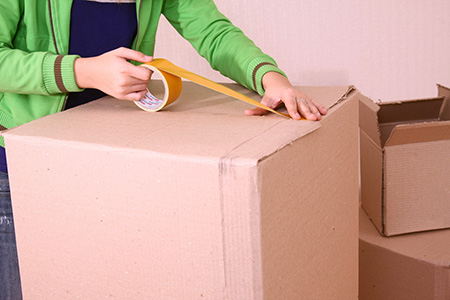 One of the biggest mistakes that people make moving home is not having enough packing materials and they end up wasting time and effort getting more supplies.
One of the biggest mistakes that people make moving home is not having enough packing materials and they end up wasting time and effort getting more supplies.
Use this guide to calculate how many boxes you need to move home
A useful packing tip is to photograph and label all the connections to items such as computers. Then when it is time to reconnect them, you only need to refer to the photographs to prevent any wrong connections being made.
Packing Materials
These are the packing materials you will need when moving home:
- An assortment of different-sized boxes
- Good quality packing tape
- Bubble Wrap
- Packing paper
- Industrial cling film
- Strong bin liners
- Blankets, towels, or old clothing
- Marker Pens
The quality of the packing materials you use has a direct impact on the level of protection they afford your precious things. The thicker the cardboard box walls, the better they will stack and the more impact protection they will offer the contents.
Invest in good quality packing tape. Cheap tape will not adhere to the boxes as well as quality tape will and you will end up using twice as much for the same level of support that good tape will seal a box at.
Find out all you need to know about packing materials
Labelling Moving Boxes
Take the time to properly label all your moving boxes. This will make it easier to identify which room the box needs to be placed in at the new home and will assist you in finding an item quickly if you need it before all the boxes are unpacked.
Using different coloured pens or tape on the boxes will make them easier for everyone to identify. Blue for the bathroom, green for the kitchen, etc.
Learn more about labeling boxes: How to Label Boxes the Write Way
How to Pack a Moving Box
- Size matters. Use small boxes for heavy items and large boxes for light items.
- Tape the flaps closed. To securely tape the flaps of a box, run a length of tape along the seam where the two flaps meet. Then apply two more strips across the width of the box.
- Add a layer of protection. Pad the inside bottom of the box with bubble wrap, scrunched-up paper (avoid using newspaper as the ink can rub off onto your things), old towels, or blankets. This will create a soft nest for your things to sit in and offer a good level of protection.
- Pack things so that they cannot move about. Fill any loose spaces in the box with padding so that the contents cannot move about inside the box.
- Add a final layer of protection. Once you have filled the boxes be sure to add a final layer of padding on top before sealing the box closed.
- Seal the box shut. Use the same method as when you constructed the box to ensure the box is well sealed.
- Label the box. Be sure to label the box so you know what is inside and which room it will go to in your new home.
Because packing is such an important part of moving home, we have dedicated a whole section of moving guides to that topic. Be sure to visit it for comprehensive instructions on how to pack and protect all your household items.
Must read: Everything you Need to Know About Packing for a Home Move
How to Move Furniture by Yourself
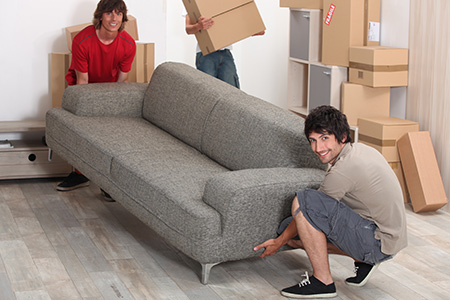 As always, your safety should be your number one concern when attempting to move heavy and large furniture or appliances. Always use the right moving equipment and get help to move large or heavy pieces of furniture.
As always, your safety should be your number one concern when attempting to move heavy and large furniture or appliances. Always use the right moving equipment and get help to move large or heavy pieces of furniture.
Before attempting to move your furniture you should produce a floor plan of your new home. It makes little sense to go to all the trouble of packing and moving your wardrobe for example only to find that it is too tall for your new bedroom.
Good to know: How to Create a Floor Plan
What Equipment Do I Need to Move Furniture?
Having the right equipment to move your furniture and appliances will make it easier and safer for you and the item. Here is a list of the equipment you are likely to need, most of which can be hired from your local tool hire shop.
- A dolly: Also called a sack-barrow or hand cart. This one piece of equipment will save you time and make moving things so much easier. You can even get ones that are specific for climbing stairs which you may find useful.
- Flatbed dolly: This is a four-wheeled, flat perform that you load your pieces of furniture or appliances onto. You will need assistance when loading a flatbed trolley.
- Lifting straps: These are straps that wrap around your body and underneath the item being moved. It requires two people to use these, but it relieves the stress on your back and makes lifting easier.
- Sliders: To move furniture over hardwood floors without scratching them use furniture sliders. These pads slip under the item and can then be slid over the floor. For lighter pieces of furniture old blankets or cardboard can serve the same purpose.
- Personal safety equipment: Non-slip gloves will help you get a good grip when moving your furniture or appliances. Strong shoes, never open-toed shoes, with a good grip should be worn. Avoid over-tight or flowing, loose clothing. Clothing should be comfortable, non-restrictive, and close-fitting enough that they cannot get caught on door handles for example.
How to Lift Heavy Furniture – Proper Lifting Techniques
It is important to know how to lift things properly to prevent injuring yourself.
- Get into a stable position: To maintain balance, stand with your feet slightly apart, with one leg slightly forward.
- Secure a good grip: Secure a good comfortable grip of the item and hold it as close to your body as possible.
- Lift slowly: Lift slowly, slightly bending your back, hips, and knees. Avoid stooping or squatting to lift.
- Avoid flexing your back: As you begin to lift avoid flexing your back, this happens when you straighten your back before raising the load.
- Let your body take the weight: Keep the load as close to your body as possible with the heaviest side towards you.
- Avoid twisting: Keep your shoulders level and facing in the same direction as your hips. Move your feet rather than twisting or leaning.
- Look ahead: Keep your head up, looking forward rather than down at the load.
- Move smoothly: Avoid any jerking or sudden movements that can often lead to injury.
- Know your limits: If in any doubt as to whether you can safely lift the item, then seek help.
How to Move Heavy Furniture and Appliances
- Plan the route: Ensure the route to your removal van is clear of any tripping hazards. Measure the furniture and route to ensure that the piece of furniture will fit through the available space.
- Dismantle: Dismantle as much of the furniture as possible to make it lighter and easier to move.
- Remove drawers: Take out shelves and drawers to make the item lighter.
- Slide: Slide rather than drag or lift the furniture.
- Lifting straps. Let the lifting straps take the strain, not your back.
- Hook chairs: Hook chairs around tight doorframes.
- Stand sofas: To get a sofa through a doorway, stand it upright and hook it around the doorframe.
- Get help: Get as much help as you can to assist you.
How to Move Furniture Without Lifting
Rollers are an ancient and extremely easy way to move very large and heavy pieces of furniture. Round wooden fence posts are great for this method of moving things.
- Tilt the item to be moved slightly backward
- Lay out a few poles in front of the item to create a runway
- Slip a pole under the item
- Gently lower the item onto the roller
- Using help to steady and guide the furniture roll it forward
- As a pole is exposed at the back, move it to the front to create a continuous runway
How to Move Heavy Furniture Downstairs
How to move furniture down steps using a hand truck:
- Clear the route to the van of any tripping hazards.
- Remove all shelves and drawers as well as dismantle the item as much as possible to make it lighter.
- Place the item onto the sack barrow and secure it in place using straps or rope.
- Have a helper available to guide and steady the load as you move it down the steps.
- Tilt the hand truck back towards you so that your body supports the weight of the item.
- Slowly roll the load down each step with a helper in front of you to hold and guide the load down.
How to slide furniture downstairs:
- Use wrapping blankets to pad the piece of furniture being moved.
- Then encase the item in thick, strong cardboard which will help it slide down the stairs.
- Have a helper guide the item as it glides down each step.
How to Move Heavy Furniture Upstairs
This can be extremely dangerous so make sure you have help available.
- Build a ramp up the steps using hardboard for example
- Wrap the item in blankets and cardboard as we did above
- Slowly and gently lower the furniture onto the ramp
- With a helper push the furniture up the ramp
- You can also have a helper at the top of the stairs with a rope to help haul it up
- A sack truck can also be used to pull items up stairs
- Ensure the item is well protected with padding
- Strap it securely to the hand truck
- Then taking one step at a time slowly haul the item up each step
- Have a helper push the item up from the front
- Communicate clearly with your helpers and take rests as you need to
For comprehensive instructions on how to pack and move specific pieces of furniture and appliances refer to the following guides:
Self-Drive Removal Vans
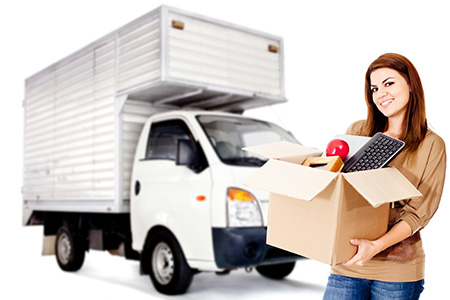 If you know someone that has a van and is willing to help you move, accept their offer of help. Driving an unfamiliar, large vehicle can be a daunting prospect for many people.
If you know someone that has a van and is willing to help you move, accept their offer of help. Driving an unfamiliar, large vehicle can be a daunting prospect for many people.
But if you have chosen to hire a van to move yourself then what do you need to know?
What size van do I need to move home?
For the average amount of contents, you will need the following size van for your home move. Consider that you may need a larger van if you have a lot of things to move, if you load the van badly, or if the weight of the items you are moving exceeds the legally permitted carrying weight of the van.
- 1-2 Bed home: 3.5t or 3500kgs
- 2-3 Bed home: 7.5t or 7500kgs
- 3-4 Bed home: 7.5t or bigger
What driving licence do you need to hire a van?
Driving licences issued before 31st January 1997:
You can drive a vehicle up to 3.5t (3500kgs) on a standard category B car driving licence.
If your driving licence entitles you to drive category C vehicles you can drive a van up to 7.5t.
Category C will allow you to tow a trailer up to 750kgs.
Driving licences issued after 31st January 1997:
You may be required to take an additional test to allow you to drive a vehicle over 3.5t.
A further test may also have to be taken to allow you to tow a trailer.
The categories you are entitled to drive can be found on the rear of your driving licence.
Driving a vehicle with the wrong driving licence will leave you liable to a fine of up to £1000 and 3-6 penalty points.
Can you Tow a Trailer on a Standard Driving Licence?
If you are considering using a trailer to move your things, here are the laws relating to towing a trailer, whether by car or van.
Driving licences issued before 31st January 1997:
You are entitled to drive a vehicle and trailer combination that does not exceed 8.25t (8250kgs)
Driving licences issued after 31st January 1997:
You can drive a car or van up to 3.5t (3,500kg) towing a trailer of up to 750kg
You can tow a trailer over 750kg as long as the combined weight of the trailer and towing vehicle is no more than 3.5t (3,500kg)
The categories on the rear of your driving licence will show you whether you are legally entitled to tow a trailer.
Does my car insurance cover me to tow a trailer? Individual policies and insurers vary so it is best to check with your insurer directly.
The information above was correct at the time of writing. Please ensure you visit the appropriate government website to ensure the laws have not recently changed.
What is the Best Way to Load a Van?
- Lay padding such as old blankets or thick cardboard on the floor of the van to prevent the edges of your furniture from being damaged.
- Load the heaviest furniture and appliances first.
- Evenly distribute the weight across the width of the van.
- Load sofas vertically to save space.
- Load long pieces of furniture and mattresses against the sidewalls of the van and secure them in place with ropes or straps.
- Large mirrors and valuable paintings can be slid between mattresses to offer more protection.
- Face cupboard drawers and doors towards a solid object so that they cannot open in transit.
- Place old blankets or thick cardboard between items to prevent their movement and add another layer of protection.
- Utilise all available space inside the van, between chair legs for example.
- Never carry anything in the cab with you as flying boxes can cause serious injury in even a minor accident.
How to Load Boxes in a Removal Van
- Load similar-sized boxes at the same time to maximize the space in the van.
- Stack boxes heaviest first with the lightest on top.
- Fragile items should be loaded on top of the box stack or placed between chair legs for example.
- Between each vertical layer use restraining straps to secure the load.
- Stuff bags of soft furnishings between the stacks and the roof to maximize space.
- Leave awkwardly shaped items till last or as gap fillers.
- Without crushing anything, load the van as tightly as possible.
- If you are not moving a full van load, keep the load as level as possible, front to back.
- Secure the load in place with restraining straps before closing and locking the back doors.
Tips for Driving a Self-Hire Van
- Ensure you know where all the controls such as indicators are.
- Adjust the mirrors and seating
- Note that many newer vans will have a 6th gear that you may be used to.
- A van will not react to your driving inputs as a car would. It reacts slower, both to stop and to accelerate. Adjust your driving accordingly.
- Beware of any height restriction on the route to your new home. Note the height of the van, make a note of it, and stick it on the dashboard if you need to.
- The extra height of the van affects stability. Take corners slowly and smoothly.
- Turn into corners wider as the van is long as will need more clearance from the kerb.
- Be especially aware of cyclists when turning.
- Use your mirrors constantly.
- Use the 4-second rule as a minimum. You should be at least 4 four seconds behind the vehicle in front of you.
- Have someone guide you when parking or reversing. Reverse slowly and use your mirrors constantly.
Learn more: Self-Drive Removal Vans – Everything you Need to Know
Moving Home by Car
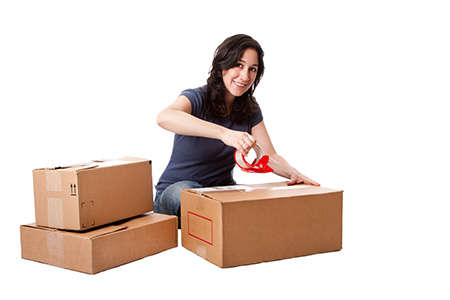 If you are only moving a few things then you may be able to transport them to your new home by car.
If you are only moving a few things then you may be able to transport them to your new home by car.
Always think safety first:
- Never carry boxes or items in the front of the car or loose. In the event of an accident, they will become flying missiles.
- Consider creating a barrier to prevent the load from shifting forward in the event that you have to brake sharply.
- Keep the spare tyre, tools, and emergency roadside kit easily accessible.
- A heavy car will take a longer braking distance to stop.
- Take corners smoothly and steadily.
- Avoid sharp braking or heavy acceleration.
- Consider the load-bearing capacity of your tyres, there is a maximum weight that they are designed to perform at.
- If your rearview is obscured by the load, get someone to guide you when reversing.
How to Prepare Your Car for Moving Home
- Check and top up all the fluids.
- Have the car serviced a few weeks before moving day. This will give you time to get any problems rectified before you move.
- Check tyre pressures and inspect the tyres for any signs of wear or damage.
- Remove the spare wheel and wheel changing tools before loading the car as they will be inaccessible once your car is loaded. Remember to reload them before setting off.
- Keep your emergency roadside kit easily accessible too.
How to Safely Lift Things In and Out of a Car
How to load a car safely:
- Before lifting, test the weight of the item
- Lift with your knees, not your back, keeping your knees bent whilst you lift
- Keep the object as close to your body as possible
- Use the bumper or side of the car to brace yourself
How to unload a car safely:
- Stand as close to the car as possible
- Lower yourself with your legs and hips when lifting an item
- Keep your head straight and look forward
- Use both hands to move the items toward you before lifting
- Keep the item close to your body
- Extend your legs and keep your back straight when lifting
- Use the bumper or boot ledge to take the weight of the item, allowing you to adopt the correct lifting position.
- Avoid overstretching to reach items.
How to Pack When Moving Home by Car
- Remove all non-essential items from your car to create more space.
- Use as few boxes as possible as they are harder to fit into a car.
- Pack fragile items into small boxes.
- Use vacuum packs to reduce the volume of soft furnishing or clothes.
- Fill rucksacks and suitcases if you intend to take those.
- Bin liners are great for clothes or soft furnishings as they can be pushed and squashed into small spaces.
- Load the car evenly, with heavy items low and towards the centre of the car.
- Place essential items into the car first in case you run out of space.
- Load the largest items first and pack the smaller things around them to prevent them from moving about.
- Keep all valuables out of sight and well-buried within the load of the car.
- Avoid leaving your car unattended if you have to make a stop en route to your new home.
- Face labeled boxes inwards so the content labels are not visible through the car windows.
- Take plenty of drinks and snacks for the journey to your new home.
You might also like to read:
You will find many more helpful guides and tips in the articles below to help you move home by yourself.
Posted on February 18, 2020
Peter Langley
Peter is a regular contributor to the blog and a relocation specialist. He is also a seasoned UK and International homeowner, who now brings the knowledge gained from those moves, to add real-life experience to his work.
Peter has also been at various sales and marketing positions within companies in the industry so he has deep knowledge of the relocation process.
Since 2017, Peter is involved with the relocation industry in the USA as he has extensive knowledge on long distance household relocation. With his articles, he have helped tens of thousands of people plan their relocation. His work have been featured on many industry blogs and publications.
You can contact Peter at peter@mymovingreviews.com
 Your health and safety should always be your first priority when moving home, so if you are in any doubt as to whether you can safely lift and move heavy boxes and furniture yourself, hire a professional removal company.
Your health and safety should always be your first priority when moving home, so if you are in any doubt as to whether you can safely lift and move heavy boxes and furniture yourself, hire a professional removal company.

 If you are planning on moving home by yourself then it makes sense to get as much help from friends and family as you can, especially if you have lots to pack, or heavy furniture to be moved.
If you are planning on moving home by yourself then it makes sense to get as much help from friends and family as you can, especially if you have lots to pack, or heavy furniture to be moved. Packing for a home move is no easy task and it should not be underestimated how long and tedious a job packing is.
Packing for a home move is no easy task and it should not be underestimated how long and tedious a job packing is. One of the biggest mistakes that people make moving home is not having enough packing materials and they end up wasting time and effort getting more supplies.
One of the biggest mistakes that people make moving home is not having enough packing materials and they end up wasting time and effort getting more supplies. As always, your safety should be your number one concern when attempting to move heavy and large furniture or appliances. Always use the right moving equipment and get help to move large or heavy pieces of furniture.
As always, your safety should be your number one concern when attempting to move heavy and large furniture or appliances. Always use the right moving equipment and get help to move large or heavy pieces of furniture. If you know someone that has a van and is willing to help you move, accept their offer of help. Driving an unfamiliar, large vehicle can be a daunting prospect for many people.
If you know someone that has a van and is willing to help you move, accept their offer of help. Driving an unfamiliar, large vehicle can be a daunting prospect for many people. If you are only moving a few things then you may be able to transport them to your new home by car.
If you are only moving a few things then you may be able to transport them to your new home by car.